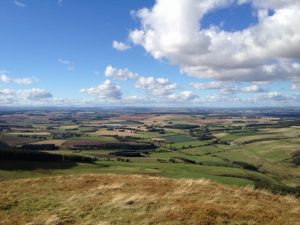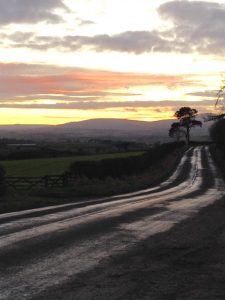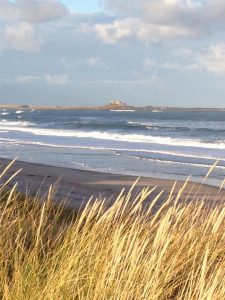CUTHBERT’S WAY and BEYOND
Beth was home for a few days in November. Unbelievable weather, still and sunny, saw us out walking along the ridge to Wideopen and Grubbit. The rolling hills stretched away to the horizon left and right. Below, the Bowmont and Kale valleys slowly filled with mist. A kestrel flew by and fieldfares and redwings led us home, flying from tree to tree, as the moon rose.
It was the first time Beth and her mum had walked this way. Earlier that day I had given them copies of my poetry collection. It contains a short one about the same walk. It appears below; ‘ a one I did earlier’ kind of moment.
“Over Grubbit and Wideopen
Cumulus clumps were strung out,
Above the hills in the blustery blue
Birds were all about.
A kestrel hovered over the heather
Wibble wobbling in the gusts,
In a sideways sweep and plummet down
The sun coloured its wings all rust.
High in the blue two crows cavorted
Polished black by the sun,
Performed a corkscrew roll, croaked in delight,
Together in gay abandon.
Swallows and martens
Southward bound
Flew leisurely by
Without a sound.
Summer was over. (1)
On our walk a sign told us that Wideopen is the halfway point of Cuthbert’s Way. This is a long distance walk which follows the route taken by St Cuthbert in the seventh century, from Melrose abbey to Holy Island.
Sainted for his missionary work, Cuthbert was also renowned for his deep attachment to the natural world, especially that around his homes on Holy Island and the Farne islands. There he laid down rules for the protection and conservation of eider ducks.
On his journey there he might have taken a backward look at the sun setting over the Cheviots.
As he approached Holy Island he would have been uplifted by his first sight of this special place.
From such visions was his deep connection with the natural world borne. Recent ‘deep’ readings ( see recent Synchronicity article) of the Prelude by William Wordsworth reminded me just how much he too was similarly embedded.
“for in all things
I saw one life and felt it was joy
One song they sang.” (2)
A few weeks after our walk on Wideopen, I was inclined to follow Cuthbert and visit his destination. As always the Lindisfarne Nature reserve was full of the delights familiar to him. I once wrote about them thus.
“Over to Lindisfarne where the waterworld
Is shaped by mud and inlets,
Where shelduck, shoveler, wigeon, teal,
Lapwings, redshank and curlew all come to feed.
Today, frosted and bright
Their colours and movements
Shine in the wintry light.
Emerald sheens, ochre stripes,
Russet patches, black flashes,
Pure whites.
The mudflat world of visual delights.
Down by the sea
Waves roll in white topped
And imprint the sand
In a brief memory.
Sanderlings pitter patter there
While eider surf the swell
And gulls soar above
This other Lindisfarne waterworld. (3)
Cuthbert the conservationist was still on my mind when we set off south for some family reunions. Amongst all the catch up chat two Cuthbert related birdwatching experiences happened. Driving into Combe I looked up towards our former home of Gladstone Cottage. Above it something amazing was happening. Five red kites were wheeling away as only they know how. As a boy such an ornithological delight was an impossibility. Back then even a sight of a buzzard was a rarity so this sighting amounted to the bird comeback of all time. Further confirmation followed two days later in Wales. Fifty years previously I had been part of a trip to Tregaron in search of the last few British red kites. A very brief sighting of one perched in a tree was the reward. Now in 2018 back in mid Wales red kite abound and we were treated to the sight of one hundred birds gathered over a feeding station.
Each passing day just now brings dire warnings of environmental collapse. Evidence abounds testifying that human kind is self inflicting a ‘tragedy’ upon its planetary commons. Earlier warnings by the likes of Rachel Carson have not been heeded. (4) Even the world of vinyl echoed her sentiments back in 1977 as John Martyn elegaically reminded listeners in his haunting song;
“of one world, like it or not
There’s one world believe it or not
There’s one life like it or not
To make our place in one world
To take our place in one world.”(5)
If only we had listened. Is there any solace to be had? Well maybe the existing beauty of the world Cuthbert championed thirteen hundred years ago and the return of the red kite to Great Britain after years of persecution offer the prospect of a different future.
Habitats can be nurtured and life returned to them if we try. Such hope is needed to help us see a way forward. Thomas Hardy was attuned to the unique role birds can play in sustaining that hope. At the turn of the last century, depressed, he was finding it hard to see a way forward. Then while out walking at dusk, a mistle thrush began to sing. His final verse speaks for us now.
So little cause for carollings
Of such ecstatic sound
Was written on terrestrial things
Afar or nigh around
That I could think there travelled through
His happy good night air
Some blessed hope whereof he knew
And I was unaware. (6)
Taking ones own small steps can help build on that hope and in doing so mitigate against the gloom. Reducing and compensating for our carbon footprint is one way. Subscribing to Climate Care after a trip would support tree planting worldwide. Similarly Tree Aid promotes the same. Through its efforts the food bearing baobab, dawadawe, cashew, and shea trees are being restored throughout the dry zones of Africa. (7) A subscription would help the indigenous peoples and combat climate change. A recent engrossing publication, the Hidden Life of Trees, spells out just how and why they are a such a key part of the way forward. (8)
In keeping with a constant feature of my musings, I‘ll end with another vinyl reference. To commemorate its release fifty years ago, the Beatles White album has been re-released. (9) My favourite track, George Harrisons ‘ While My Guitar Gently Weeps’ is covered in various ways. 1968 was a tumultuous year, a mood which the album captures. Fast forward to this troubled era and Georges wistful lyric of hope is even more needed.
“I look at the world and I notice its turning
While my guitar gently weeps
With every mistake we must surely be learning.”
Then later on in the double album Lennon and McCartney offer a bit of advice as to where the answers will be found.
“Sit beside a mountain stream – see her waters rise
Listen to the pretty sound of music as she flies.
Find me in the field of grass – Mother Nature’s son.”
And should we still be in need of awareness, “waiting for this moment to arise” follow Mother Nature’s son and walk out at dusk and
listen for
“the Blackbird singing in the dead of night”
Peaceful ‘Revolutions’ have to start somewhere.
References.
From Lines of Life. Christopher Archer. Amazon e book.
Wordsworth. William. The Prelude.
From Lines of Life. ibid
Carson. Rachel. The Silent Spring. 1962. Penguin Modern Classic.
Martyn. John. 1977. Album entitled One World.
Hardy. Thomas. from ‘The Darkling Thrush’.
Climate Care and Tree Aid. Accessible on line.
The Hidden Life of Trees. Wohlleben P. 2017. Collins
The Beatles. White Album. 1968. tracks cited are
While My Guitar Gently Weeps
Mother Nature’s Son
Blackbird
Revolution.



